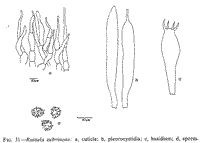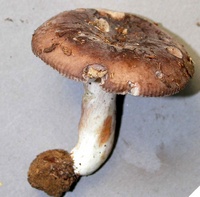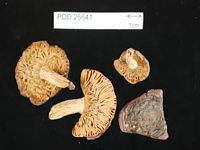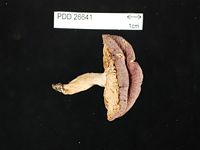|
 Russula subvinosa Russula subvinosa
BiostatusPresent in region - Indigenous. Endemic
Images (click to enlarge) | 
Owner: P. Leonard | 
Caption: Dried type specimen
Owner: Herb PDD | 
Caption: Dried type specimen
Owner: Herb PDD | |
Article: McNabb, R.F.R. (1973). Russulaceae of New Zealand. 2. Russula Pers. ex S.F. Gray. New Zealand Journal of Botany 11(4): 673-730 (http://www.rsnz.org/publish/abstracts.php).
Description: pileus: 4-6.5 cm diam., convex when young, centrally
depressed at maturity, slightly viscid under wet conditions, otherwise dry,
glabrous to finely rugulose, pruinose to subvelutinate under lens, velar remnants
absent, greyish pink, greyish red, dull red, or pallid vinaceous, occasionally
deep vinaceous in centre, often mottled greyish pink and white, typically with
grey overtones in dry weather, sometimes with greenish yellow areas; margins
entire, non-pectinate. Cuticle composed of erect, thin-walled, smooth, septate
or aseptate, hair-like hyphae to 50 µm long, without staining contents in KOH,
tapering apically, originating from slightly to moderately inflated, short-celled
hyphae, becoming disorganised with age; pilocystidia absent. lamellae: adnate, moderately crowded, thick, simple
or forked near stipe, to 7 mm deep, cream, not discoloured at maturity, lamellulae
present. stipe: 2-4 cm long, ± equal or tapering basally,
1-2 cm diam., dry, solid, finely felted under lens, white to pallid creamy white;
flesh white, unchanging on exposure to air. Cuticle composed of a loose palisade
of hair-like hyphae similar to those of pileus, soon disorganised with age;
caulocystidia absent. spores: spore
print pallid ochre; spores elliptical to broadly elliptical, obliquely apiculate.
apiculus to 1.5 µm long, 9-11 X 8-9.5 µm, ornamentation of rather sparse, amyloid
or partially inamyloid crests and ridges to 1.2-(1.6) µm high, forming an almost
complete reticulum; plage conspicuous. hymenium: basidia hyaline, clavate, 35-52 X 11-15.5 µm, 4-spored, sterigmata
to 7 µm long; pleurocystidia scattered, numerous, fusiform, hyaline, thin-walled
or slightly thick-walled, contents sparse, projecting to 30 µm beyond basidia,
apices acuminate, or protracted and capitulate, 63-91 X 7-12.5 µm; cheilocystidia
rare to moderately numerous, similar to pleurocystidia but shorter. hymenophoral
trama: heteromerous, intermixed. context of pileus: white, firm, unchanging; structure heteromerous,
clamp connections absent. taste: lamellae and context mild. chemical characters: formalin on context—n.r.; phenol on context—slowly
deep vinaceous; FeSO4 on context—rapidly pallid salmon pink; KOH and NH4OH on
pileus and context—n.r.
Habitat: Solitary or occasionally in pairs under Leptospermum
and Nothofagus.
Notes: This species belongs to the section Rigidae
and is possibly best placed in subsection Amoeninae as defined by Singer
(1962), but spore print is slightly coloured.
Collections associated with Nothofagus
spp. perhaps do not entirely agree in spore ornamentation with those from under
Leptospermum, and in their chemical relation with KOH, but for the time
being it seems best to include them under the same species.
|